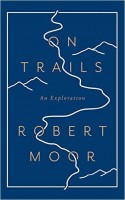On Trails: An Exploration
by Robert Moor
(Aurum Press, £16.99)
 In the words of the Chinese philosopher Zhuangzi, paths are made by walking. Robert Moor tried to make his own on the rim of a glacial fjord on the Canadian island of Newfoundland. He spent an hour at a time on it, being mauled by spruce and fir, only to find that he had covered no more than 50 yards: “It was a dark and pestilential place. The apparent beauty was only a ruse to lure you into its flytrap maw. I vowed to myself that, if I made it out of this alive, I would never hike again.”
In the words of the Chinese philosopher Zhuangzi, paths are made by walking. Robert Moor tried to make his own on the rim of a glacial fjord on the Canadian island of Newfoundland. He spent an hour at a time on it, being mauled by spruce and fir, only to find that he had covered no more than 50 yards: “It was a dark and pestilential place. The apparent beauty was only a ruse to lure you into its flytrap maw. I vowed to myself that, if I made it out of this alive, I would never hike again.”
He did make it out, which is why we have this marvellous book, one that’s easier to enjoy than it is to summarise. Moor began work on it in 2009, after walking the 2,200-mile Appalachian Trail between Georgia and Maine, a trail dreamed up in the 1920s by Benton MacKaye, a forester and utopian, as “a sanctuary and a refuge from the scramble of every-day worldly commercial life”.
The book is “on” trails in two senses: it’s the fruit of miles of walking and of years of research. He starts with the trails left by organisms of the Ediacaran biota, which became extinct about 541 million years ago, and ends with the longest hiking trail in the world, a global footpath, a collective effort, that’s very much the offspring of the internet. (It’s the International Appalachian Trail — I’d never heard of it until I read this book.)
In between, he considers the trails made by insects, animals and man, and the purposes to which they have been put, from finding food to building empires. While the Appalachian Trail, which prompted his inquiry, provides a main line, he branches off it in all directions, hiking everywhere from Canada to Morocco and considering the trail as everything from a means of recreation to a metaphor for life.
As hikers do, he takes a while to settle into a rhythm. His vocabulary in the prologue (perfused, heliated, myrmecine) is a little off-putting, as is his declaration, after devoting an opening chapter to the Ediacaran, that what they left behind were not really trails but traces (the distinction being that a trace becomes a trail only when it has been followed).
Then he gets properly into his stride with a chapter on ants, “the world’s greatest trail-makers”, revealing that ant-colony algorithms — “in which myriad initial routes are explored, the best ones being amplified while the others fade” — have been used to improve everything from Britain’s telecommunications networks to the delivery of disaster relief.
He considers, too, the trails of four-legged animals, how they navigate vast territories and how our efforts to hunt, herd and study them have shaped our development as a species. He spent three weeks as a shepherd with a Navajo family in Arizona, and before 10am on the first day managed to lose all their sheep. He spent hours up a tree with an expert tracker and hunter — a man who had shot seven white-tailed deer that season alone — without seeing a kill.
He may be an incompetent shepherd, and a bit of a jinx, but he’s a companionable and dependable guide on the trail. His book is big-hearted as well as ambitious. Among the many touching incidents he recounts is one in which a long-distance hiker, about to give up, is lifted by offers of help from those he has met on the way.
Until he began looking into trails, Moor says, he had viewed our planet as a stable, serene place whose delicate balance humans had upset. “I now see the earth as the collaborative artwork of millions of sculptors, large and small. Sheep, humans, elephants, ants: each of us alters the world in our passage.” MK
A shorter version of this review appeared on Telegraph Travel

Leave a Reply